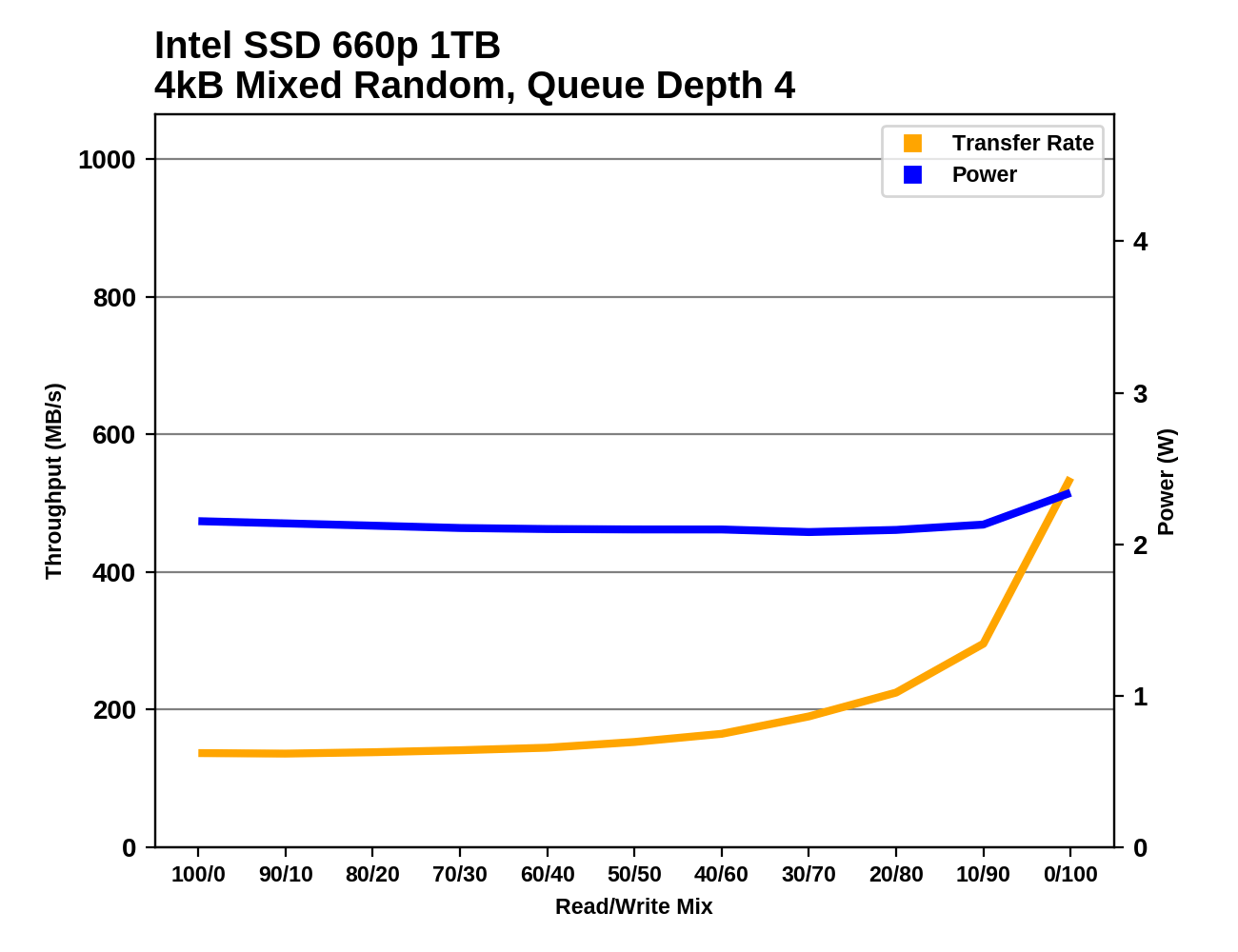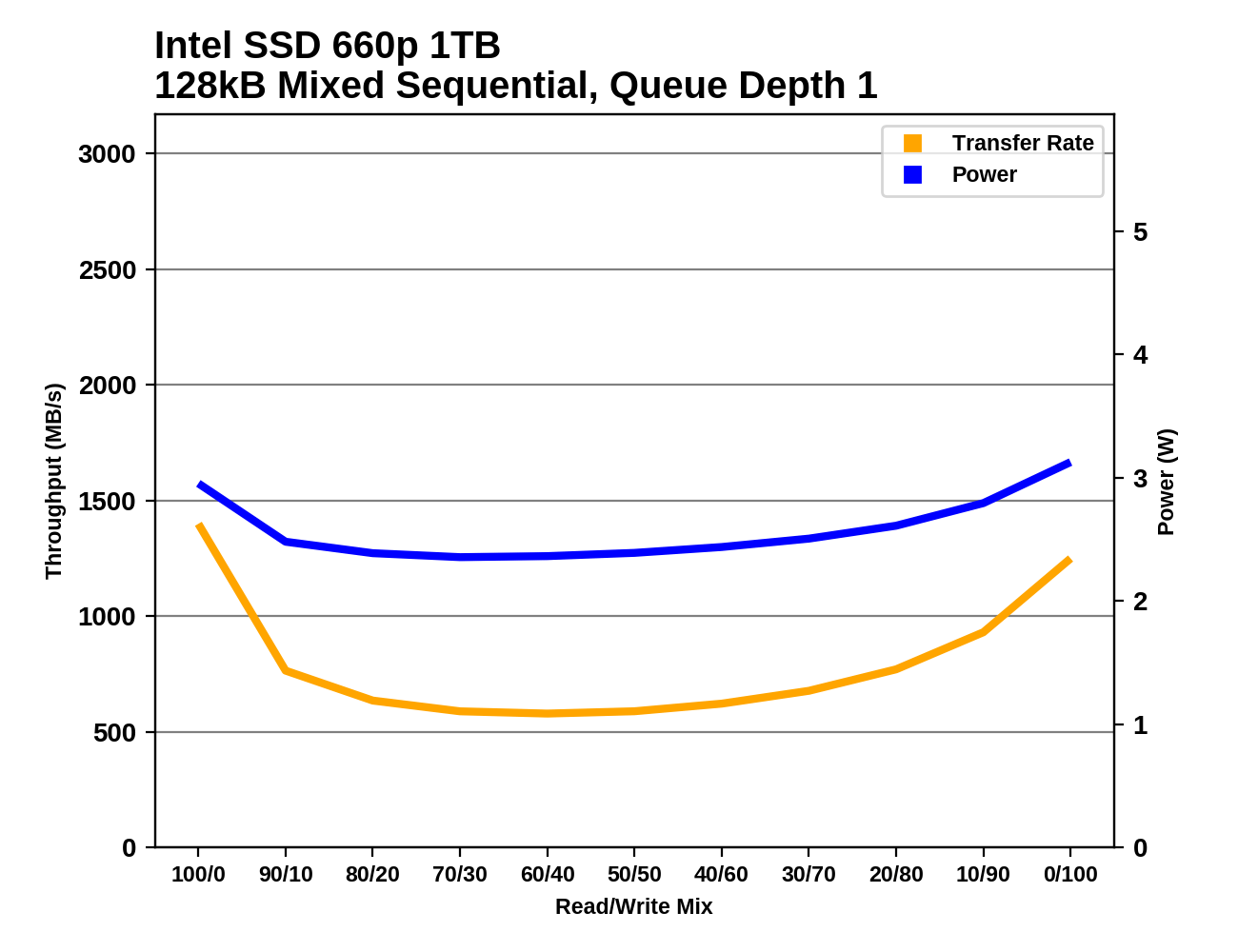The Intel SSD 660p SSD Review: QLC NAND Arrives For Consumer SSDs
by Billy Tallis on August 7, 2018 11:00 AM ESTMixed Random Performance
Our test of mixed random reads and writes covers mixes varying from pure reads to pure writes at 10% increments. Each mix is tested for up to 1 minute or 32GB of data transferred. The test is conducted with a queue depth of 4, and is limited to a 64GB span of the drive. In between each mix, the drive is given idle time of up to one minute so that the overall duty cycle is 50%.

The mixed random I/O performance of the Intel SSD 660p is clearly above the other low-end NVMe drives we've tested, or the Crucial MX500 SATA drive. It scores closer to a mid-range NVMe SSD. After filling the drive, performance is cut in half, leaving it performing near low-end NVMe drives like the Phison E8-based Kingston A1000 and below the MX500.
 |
|||||||||
| Power Efficiency in MB/s/W | Average Power in W | ||||||||
The power efficiency of the 660p during the mixed random I/O test is unimpressive but doesn't stand out as being significantly worse that other low-end NVMe drives even when the test is run on a full drive.
 |
|||||||||
The Intel SSD 660p shows very slow performance growth throughout most of the test, but it picks up speed reasonably well toward the end as the workload shifts toward pure writes, and the SLC cache handles things well. When the drive is full, the reduced capacity of the SLC cache prevents speed from increasing much.
Mixed Sequential Performance
Our test of mixed sequential reads and writes differs from the mixed random I/O test by performing 128kB sequential accesses rather than 4kB accesses at random locations, and the sequential test is conducted at queue depth 1. The range of mixes tested is the same, and the timing and limits on data transfers are also the same as above.

The Intel SSD 660p performs better than other entry-level NVMe SSDs or SATA drives when the mixed sequential I/O test is run on a mostly empty drive with a large SLC cache. After the drive is filled, performance drops down to slightly ahead of the 600p and Crucial MX500.
 |
|||||||||
| Power Efficiency in MB/s/W | Average Power in W | ||||||||
The power efficiency of the Intel SSD 660p during the mixed sequential I/O test is decent when operating entirely out of the SLC cache, and on par with most other low-end NVMe drives when the 660p is full.
 |
|||||||||
When the test is run on a mostly-empty 660p the performance shows a very typical bathtub curve and no sign of the SLC cache running out. When the drive is full, performance decreases steadily as the proportion of writes increases.










86 Comments
View All Comments
mapesdhs - Wednesday, August 8, 2018 - link
If you have quite literally "valuable info" then don't use a consumer SSD at all. Heck, damn the speed, you're far better with even a used 840 Pro. That's why I obtained one for this build I did, along with an SM951 for a scratch video drive:http://www.sgidepot.co.uk/misc/charitypc1.html
BurntMyBacon - Wednesday, August 8, 2018 - link
First point of interest is always have a backup plan. If information is valuable, don't rely on any single copy of it.As to your question of endurance, I don't think most personal use cases are likely to have an issue. If you have a professional workload, get a professional drive. The 840 Pro that mapesdhs keeps evangelizing is actually a pretty good option, though a Pro series (MLC) nvme drive will provide better performance while still providing endurance is the same ballpark as the 840Pro.
As to whether it will refresh the cell if powered on, I would expect most Samsung drive will, though it is not known whether
BurntMyBacon - Wednesday, August 8, 2018 - link
As to whether it will refresh if powered on, I don't believe that Samsung flash required the refresh cycle once the moved to 3D NAND with a larger feature size. That said, since QLC halves the voltage swing (and corresponding charge) vs TLC, it is likely that Samsung will need to do something to prevent voltage drift. This may not necessarily require active refreshing, though. It is not known (by me) whether this is a requirement for other manufacturer's 3DQLC NAND either.BurntMyBacon - Wednesday, August 8, 2018 - link
I get why they don't want an edit feature, but would it really hurt if they added a time limited recall type edit feature for when you fat thumb a hot key that posts your unfinished message before you are done with it. Maybe give you five minutes after a post initiate the edit to catch typos or grammar issues. It wouldn't really be enough to alter a conversation as it is unlikely that others will have responded within this time frame.AbRASiON - Tuesday, August 7, 2018 - link
Considering the abysmal performance of this thing, I think you really need a $/GB chart on the page and it would be nice to put in a very fast, modern hard drive. Something huge and 7200RPM with a lot of cache on it.Just to put it in perspective, because as it stands, wow this thing looks terrible. I expect VERY cheap prices if they're gonna run like this.
Oxford Guy - Tuesday, August 7, 2018 - link
No matter how terrible QLC is it is going to succeed in the market because consumers respond well to big and cheap.So, I think one interesting question is going to be how much disguising there will be of products having QLC. Microcenter, for instance, is apparently selling a TLC Inland drive, calling it MLC.
piroroadkill - Wednesday, August 8, 2018 - link
That's how I want QLC drives to be compared - to the best hard drives people might actually buy today to store their games on, for example.I'd love a cheap and large 4TB drive for my games, but it has to be both much faster than the HDD setup I use for games (2× 2TB 3.5" Seagate Hybrid drives in RAID0) and not too far off the same price.
zodiacfml - Wednesday, August 8, 2018 - link
Impressive performance. Easily beats my SATA 850 EVO in performance and twice the capacity I bought last December for the same price.There should be no reason for notebook manufacturers to settle for HDD except the cheapest laptops.
mapesdhs - Wednesday, August 8, 2018 - link
Given the 850 EVO's strong reliability reputation though, I wouldn't be overly eager to recommend this new QLC model for anyone wanting a decent degree of confidence that their data is safe. But then, most consumers don't have backup strategies anyway. :DSpunjji - Wednesday, August 8, 2018 - link
If you want safe data, make regular backups. Anything else is a false sense of security!